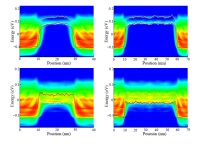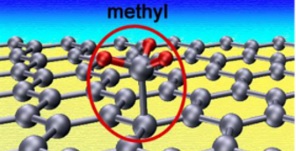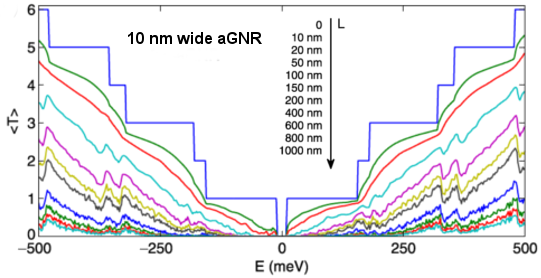Context and objectives
Modelling and simulation is a transverse activity inside the “Micro and Nano Electronics Devices” research group.
The research activity of the modelling and simulation group is devoted to study electron transport of innovative devices such as multi-gate transistors, nanowire FETs, graphene-based devices and mesoscopic structures.
The group has a solid experience in developing homemade numerical codes to solve the 3D/2D/1D self-consistent Poisson-Schrödinger equation with k.p and tight-binding Hamiltonians for accurate band profile calculations and hence to compute electronic and transport properties (LDOS, current density, conductance, mobility). Quantum transport is treated within the general Keldysh-Green’s function formalism, which allows us to take into account non-equilibrium effects elastic scattering due to roughness, charged defects and traps and inelastic interactions such as electron-phonon scattering.
The analytical modelling activity develops physically based analytical models for advance CMOS (Single Gate and Multiple Gates) architectures to improve core models for industrial compact MOSFET models such as PSP and predict MOSFETs performances along the roadmap.
The physical models developed by the group aim at:
- Predicting and optimising the device performance,
- Explaining experiments and characterization data
- Supporting the experimental work performed in the laboratory as the derivation of physically significant parameters from electrical characterisation.
Expertise in modelling
- Development of physically based analytical models for advance CMOS (Single Gate and Multiple Gates) architectures including: Quantum confinement, Quasi Ballistic transport, Strained channels, Leakage currents (Short Channel Effects, Band to Band Tunnelling, Source to Drain Tunnelling),
- Improvement of core models for industrial compact MOSFET models such as PSP,
- Prediction of MOSFETs performances along the roadmap,
- Transport in Ultra Thin Dielectrics, including High K materials
- Modelling of advanced Non Volatile Memory (Flash, Nanocrystal NVM): erase and writing time, retention time and reliability
- Diagrammatic technique for transport properties of the single-electron transistor at different orders of the tunnel-coupling with both normal and superconducting leads
Expertise in numerical simulation
- Simulation of quantum transport in nanostructures like semiconductor nanowires, graphene-based structures and mesoscopic devices
- Resolution of the (3D, 2D, 1D) self-consistent Poisson-Schrödinger equation for accurate band profile calculations
- Calculation of transport properties (charge or spin) of nanodevices based on the Keldysh-Green's functions approaches with the inclusion of spin-orbit coupling and external magnetic fields
- Modelling of the effects of elastic scattering due to surface roughness and of inelastic scattering due to phonons
- Modelling of heat transport in nanostructures
Recent results
- Simulation of quantum transport in electron nanodevices
- Magnetotransport in graphene ribbons
- Modelling of nano MOSFETs for the end of the roadmap
- Impact of mechanical strain on electron and hole transport
- Simulation of Scanning Gate Microscopy (SGM) experiments
- Transport gap in chemically modified graphene ribbons
- Andreev and Josephson currents through interacting quantum dots
- Thermoelectric energy harvesting in semiconductor nanowires
Simulation of quantum transport in electron nanodevices
Examples of local density of states (LDOS) of silicon nanowire FETs with surface roughness and electron-phonon scattering as a function of the energy and of the position along the transport direction.
The simulations are realized using different gate lengths of 20 nm (left) and 50 nm (right) for gate voltage of 0V (top) and of 0.7V (bottom)
This activity aims at developing numerical codes for the self-consistent simulation of nanoscale electron devices like nanowire or thin-body double-gate MOSFETs. Such codes solve the 3D or 2D equation of Schrödinger-Poisson with open boundary conditions along the transport direction. They are also able to treat the influence of spin-orbit coupling or of an external magnetic field.
Electronic properties, such as band structures of confined systems and density of states, are evaluated via k.p Hamiltonians or empirical pseudopotential methods in order to correctly account for the band-structure modifications induced by quantum confinement. By means of these Hamiltonians we develop a full-quantum approach based on the Keldysh-Green’s function formalism to treat carrier transport. Such a methodology is compulsory to take into account simultaneously the effects of the lateral confinement, interferences due to quantum phase coherence, as well as elastic scattering due to static impurities or surface roughness and inelastic scattering due to the electron-phonon interaction treated within the self-consistent Born approximation.
Importantly, these simulations are strongly correlated to the experimental and modelling work performed within the group.
Contact: Marco Pala
Support: Agence National de la Recherche, « NOODLES » Project, « MOSINAS » Project, « QUASANOVA » Project, « QUANTAMONDE » Project.
EU commission, « COMPOSE3 » Project, « SQUWIRE » Project, « NANOSIL » NoE, « SINANO » NoE.
Relevant publications:
- S. Brocard, M.G. Pala and D. Esseni, Large On-Current Enhancement in Hetero-Junction Tunnel-FETs via Molar Fraction Grading, IEEE-Electron Device Letters 35, 184 (2014).M.G. Pala and D. Esseni, Interface Traps in InAs Nanowire Tunnel-FETs and MOSFETs—Part I: Model Description and Single Trap Analysis in Tunnel-FETs, IEEE Trans. Electron Devices 60, 2795 (2013).
- F. Conzatti, M.G. Pala, D. Esseni, Surface Roughness Induced Variability in Nanowire InAs Tunnel-FETs, IEEE-Electron Device Letters 33, 806 (2012).
- F. Conzatti, M.G. Pala, D. Esseni, E. Bano, and L. Selmi, Strain-induced performance improvements in InAs nanowire tunnel Fets, IEEE Trans. Electron Devices 59, 2085 (2012).
- A. Cresti, M.G. Pala, S. Poli, M. Mouis, and G. Ghibaudo, A Comparative Study of Surface-Roughness-Induced Variability in Silicon Nanowire and Double-Gate FETs, IEEE Trans. Electron Devices 58, 2274 (2011).
- S. Poli and M.G. Pala, Channel-Length Dependence of Low-Field Mobility in Silicon-Nanowire FETs, IEEE Electron Device Letters 30, 1515 (2009).
- S. Poli, M.G. Pala, T. Poiroux, S. Deleonibus, and G. Baccarani, Size dependence of surface-roughness-limited mobility in Silicon-nanowire FETs, IEEE Trans. Electron Devices 55, 2968 (2008).
- Th. Schäpers, V. A. Guzenko, M.G. Pala, et al., Suppression of weak antilocalization in GaInAs/InP narrow quantum wires, Physical Review B 74, 081301 (2006).
Magnetotransport in graphene ribbons
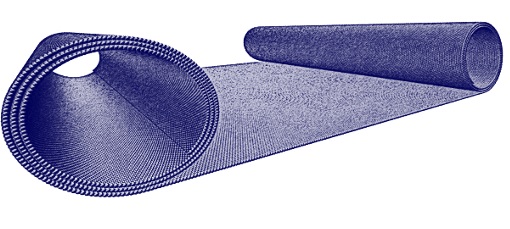
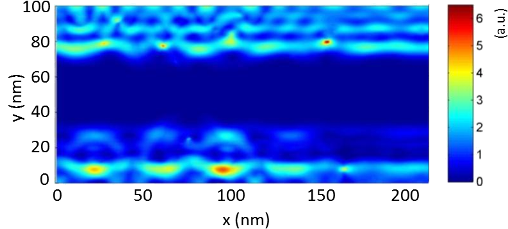
Top: A ribbon with scrolled edges.
Bottom: Spatial distribution of currents through a 100 nm wide disordered ribbon with scrolled edges and under high magnetic field
The observation of high quality integer quantum Hall effect in graphene at room temperature has galvanized the scientific community for the possible metrological applications (new standard of resistance) as well as for more fundamental physics aspects (as the degeneracy lifting of the graphene-specific zero Landau level). We investigate the interplay between magnetic field and disorder in determining the electronic transport properties of graphene ribbons. The combination of atomistic tight-binding description and full quantum Green’s function approach allows us to consider different types of experimentally relevant disorder sources as short-range potential (adsorbates, vacancies…), long-range disorder (charged impurities) and geometrical distortion (scrolls, ripples…). Depending on the disorder nature, interesting effects can be predicted, as for example the quenching of the integer quantum Hall effect in ribbons with scrolled edges or in narrow ribbons with moderate disorder.
Contact: Alessandro Cresti
Recent publications:
- A. Cresti, M.M. Fogler, F. Guinea, A.H. Castro Neto and S. Roche, Quenching of the Quantum Hall Effect in Graphene with Scrolled Edges, Physical Review Letters 108, 166602 (2012).
- K.L. Chiu, M.R. Connolly, A. Cresti, C. Chua, S.J. Chorley, F. Sfigakis, S. Milana, A.C. Ferrari, J.P. Griffiths, G.A.C. Jones and C.G. Smith, Single-particle probing of edge-state formation in a graphene nanoribbon, Physical Review B 85, 205452 (2012).
- R. Ribeiro, J.-M. Poumirol, A. Cresti, W. Escoffier, M. Goiran, J.-M. Broto, S. Roche and B. Raquet, Unveiling the Magnetic Structure of Graphene Nanoribbons, Physical Review Letters 107, 86601 (2011).
Modelling of nano MOSFETs for the end of the roadmap
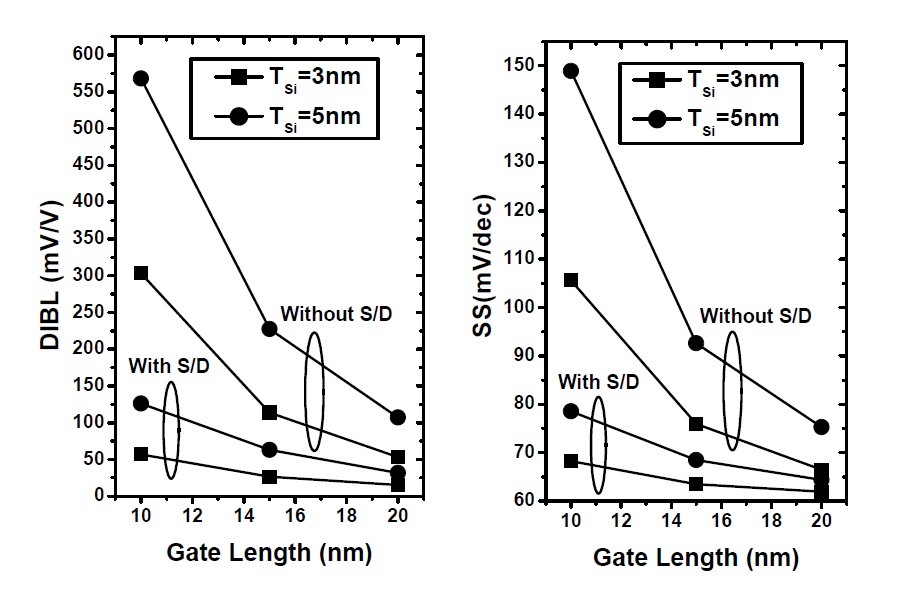
Analytical modeling of short channel effects showing the significant role of the source and drain on the value of DIBI and subthreshold slope (T. Dutta et al., ULIS Conference 2013.
We are developing analytical models in order to capture as many effects as possible (e.g. quasi ballistic transport, source-drain leakage, accurate short channel effects etc.), that are playing a key role in nano MOSFETs. These models are extensively compared to advanced simulations codes (NEGF, TCAD, MC with our collaboration with DIEGM/Udine). In particular, many studies have been focused on the evaluation of Ge and III-V channel devices, which are presently a realistic option for the end of the roadmap. A strong collaboration with the Advanced Device group in ST Microelectrics allows us to transfert our model in the MaSTar plateform and hence reach a larger audience.
Contact: Quentin Rafhay
Support: STREP Compose3 - ANR MOSINAS - ANR Noddle
See for instance: Quentin Rafhay, Raphaël Clerc, Gérard Ghibaudo, Georges Pananakakis, Impact of source-to-drain tunnelling on the scalability of arbitrary oriented alternative channel material nMOSFETs, Solid-State Electronics 52, 1474-1481 (2008).
Recent publications:
- B. Sklenard, P. Batude, Q. Rafhay, et al., Influence of device architecture on junction leakage in low-temperature process FDSOI MOSFETs, Solid-State Electronics 88, 9 (2013).
- T. Dutta, Q. Rafhay, et al., Impact of quantum effects on the short channel effects of III-V nMOSFETs in weak and strong inversion regimes, Solid-State Electronics 88, 43 (2013).
- I. Ben Akkez, A. Cros, C. Fenouillet-Beranger, F. Boeuf, Q. Rafhay, F. Balestra, G. Ghibaudo, New parameter extraction method based on split C–V measurements in FDSOI MOSFETs, Solid-State Electronics 84, 142 (2012).
- A. Zaka, P. Palestri, Q. Rafhay, R. Clerc, M. Iellina, D. Rideau, C. Tavernier, G. Pananakakis, H. Jaouen, L. Selmi, An Efficient Nonlocal Hot Electron Model Accounting for Electron-Electron Scattering, IEEE Trans. Electron Devices 59, 983 (2012).
- A. Zaka, J. Singer, E. Dornel, D. Garetto, D. Rideau, Q. Rafhay, R. Clerc, J.-P. Manceau, N. Degors, C. Boccaccio, C. Tavernier, H. Jaouen, Characterization and 3D TCAD simulation of NOR-type flash non-volatile memories with emphasis on corner effects, Solid-State Electronics 63, 158 (2012).
- A. Zaka, Q. Rafhay, M. Iellina, P. Palestri, R. Clerc, D. Rideau, D. Garetto, E. Dornel, J. Singer, C. Tavernier, G. Pananakakis, H. Jaouen, On the Accuracy of Current TCAD Hot Carrier Injection Models in Nanoscale Devices, Solid-State Electronics 54, 1669 (2010).
- M.F. Beug, Q. Rafhay, M.J. van Duuren, R. Duane, Investigation of Back-Bias Capacitance Coupling Coefficient Measurement Methodology for Floating-Gate Nonvolatile Memory Cells, IEEE Trans. Electron Devices 57, 1253 (2010).
Impact of mechanical strain on electron and hole transport
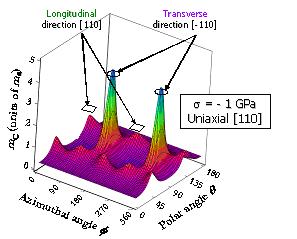
Calculation of the hole conduction mass reduction due to a longitudinal compressive stress along the [110] direction. In contrast, the transverse mass almost keeps its unstrained value.
An analytical model of electron and hole mobility in strained silicon is being developed in order to describe low field transport along any channel orientation with an arbitrary stress configuration (arbitrary stress tensor). The model, which runs in a few seconds on a standard PC, is based on an exact solution of the 6x6 k.p Hamiltonian coupled with a Kubo-Greenwood approach for mobility calculation. It can be used to support the interpretation of experimental results in terms of strain induced mobility variations or to find channel orientations and stress configurations that optimize carrier transport.
Support: ACI Contraintes (2002-2005), ANR/PNANO MODERN (2005-2008), FP7/IST
See for instance: T. Guillaume, M. Mouis, Calculations of hole mass in [110]-uniaxially strained silicon for the stress engineering of p-MOS transistors, Solid-State Electronics, Volume 50, Issue 4, Pages 701-708 (April 2006)
Simulation of Scanning Gate Microscopy (SGM) experiments: local density of states in mesoscopic structures and manipulation of electron transport
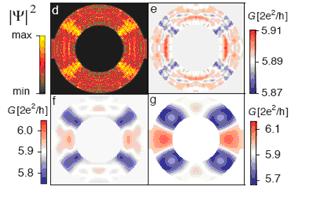
This activity concerns the modelling of advanced SGM experiments on mesoscopic devices like Aharonov-Bohm rings. Scanning gate microscopy is a weakly invasive technique, applicable to nanostructures patterned in subsurface two-dimensional electron gases and operated at low temperature. In such a cryogenic atomic-force-microscope (AFM) set-up, the probe is used as a scatterer which locally modifies the electron flow properties, or as a local gate which can be moved to any position. We support our interpretation with numerical simulations of quantum transport based on S-matrix or recursive Green's functions approach.
Marco PalaSupport: Agence National de la Recherche, « MICATEC » project
Relevant publications:
- M.G. Pala, S. Baltazar, P. Liu, H. Sellier, B. Hackens, F. Martins, V. Bayot, X.Wallart, L. Desplanque, S. Huant, Transport inefficiency in branched-out mesoscopic networks : An analog of the Braess paradox, Physical Review Letters 108, 076802 (2012)
- B. Hackens, F. Martins, S. Faniel, C. A. Dutu, H. Sellier, S. Huant, M. Pala, L. Desplanque, X. Wallart, V. Bayot, Imaging Coulomb Islands in a Quantum Hall Interferometer, Nature Communications 1, 39 (2010).
- M.G. Pala, S. Baltazar, F. Martins et al., Scanning gate microscopy of quantum rings: effects of an external magnetic field and of charged defects, Nanotechnology 20, 264021 (2009).
- H. Sellier, S. Huant, B. Hackens, M.G. Pala, Imager les interférences quantiques dans les semi-conducteurs, Images de la physique 2009, Editions CNRS.
- M.G. Pala, B. Hackens, F. Martins, H. Sellier, V. Bayot, S. Huant, and T. Ouisse, Local density of states in mesoscopic samples from scanning gate microscopy, Physical Review B 77, 125310 (2008)
- F. Martins, B. Hackens, M.G. Pala, et al., Imaging electron wave functions inside open quantum rings, Physical Review Letters 99, 136807 (2007).
Transport gap in chemically modified graphene ribbons
Top: A methyl group grafted on the graphene surface.
Bottom: Transmission coefficient, averaged over 50 disorder realizations, as a function of the electron energy for a 10 nm wide armchair ribbon with a density n = 0.1 % of methyl-group adsorbates and for different lengths of the functionalized region from 0 to 1 ?m.
The absence of band gap is a major issue for the use of graphene in logic devices, whose on/off current ratio turns out to be very poor. Graphene chemical modification is a perspective tool to open a transport gap and design efficient carbon-based logic transistors. Starting from ab initio calibrated tight-binding models, we simulate transport in nanoribbons in the presence, for example, of methyl group functionalization or boron substitutional doping. Varying the density of adsorbates and the system size and geometry allows us to engineer the transport gap. The simulation of a complete boron-doped graphene-based transistor shows that actually screening can partially reduce the expected high on/off current ratio, thus indicating the necessity for a further optimisation (in terms of doping and electrostatics) and to explore the use of different types of dopants.
Contact: Alessandro Cresti
Recent publications:
- A. Cresti, Scaling properties of diffusive electronic transport in graphene nanoribbons functionalized with methyl-groups, J. Comput. Electron. 12, 94 (2013)
- P. Marconcini, A. Cresti, F. Triozon, G. Fiori, B. Biel, Y.-M. Niquet, M. Macucci and S. Roche, Atomistic boron-doped Graphene Field-Effect Transistors: A Route toward Unipolar Characteristics, ACS Nano 6, 7942 (2012)
- S. Roche, B. Biel, A. Cresti and F. Triozon, Chemically enriched graphene-based switching devices: A novel principle driven by impurity-induced quasibond states and quantum coherence, Physica E 44, 960 (2012).
- A. Cresti, A. Lopez-Bezanilla, P. Ordejón and S. Roche, Oxygen surface functionalization of graphene nanoribbons for transport gap engineering, ACS Nano 5, 9271 (2011).
Andreev and Josephson currents through interacting quantum dots
We develop a real-time diagrammatic technique to describe non-equilibrium transport through interacting quantum dots connected to normal and superconducting leads. We compute the Josephson current given by the transport of Cooper pairs between the two superconductors and the Andreev current in normal leads. Normal contacts allow us to control the level population and to bring the dot out of equilibrium.
For a system with two superconducting leads, in the large-superconducting-gap limit, we are able to calculate the non-equilibrium Andreev and Josephson currents to all orders in the tunnel coupling with the superconducting lead.
Marco Pala
Recent publications:
- A. Braggio, M.G. Pala, M. Governale, J. König, Superconducting proximity effect in interacting quantum dots revealed by shot noise, Solid-State Communications 151, 155, (2011).
- D. J. Eldridge, M.G. Pala, M. Governale, J. König, Superconducting proximity effect in interacting double-dot systems, Physical Review B 82, 184507 (2010).
- D. Futterer, M. Governale, M.G. Pala, and J. König, Nonlocal Andreev transport through an interacting quantum dot, Physical Review B 79, 054505 (2009).
- M. Governale, M.G. Pala, and J. König, Real-time diagrammatic approach to transport through interacting quantum dots with normal and superconducting leads, Physical Review B 78, 069902 (2008).
- M.G. Pala, M. Governale, and J. König, Non-Equilibrium Josephson and Andreev Current through Interacting Quantum Dots, New Journal of Physics 9, 278 (2007).
Thermoelectric energy harvesting in semiconductor nanowires
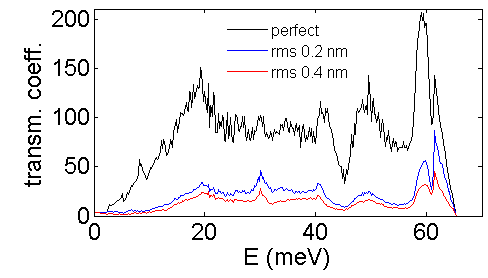
Top: Two silicon nanowires oriented along the ‹100› direction, with 5x5 nm2 section and different levels of roughness over a length of 34 nm.
Bottom: Phonon transmission coefficients for a pristine nanowire and for the two rough nanowires.
The increasing need for autonomous applications demands the development of efficient energy harvesting techniques, mainly based on thermoelectricity, piezoelectricity or photovoltaic effect. In the last decade, material nanostructuration has allowed a significant increase of the thermoelectric ZT factor of merit thanks to the combined effect of thermal conductivity decrease and moderate impact on the electron conductivity. In our group, we focus on semiconductor nanowires, which have been experimentally seen to be very promising in this respect. We describe the interatomic coupling by a valence force model, which is able to account for experimentally relevant sources of disorder such as roughness, and estimate the thermal conductivity by the Green’s function approach. The combination with electronic transport simulation, for the calculation of conductivity, Seebeck coefficient and electronic thermal conductivity, allows us to estimate the ZT factor and to explore new possible roots for its engineering lead.
See for instance: G. Ardila, A. Kaminski-Cachopo, M. Pala, A. Cresti, L. Montes, R. Hinchet, J. Michallon, M. Daanoune, M. Mouis, Towards self-powered systems: using nanostructures to harvest ambient energy, 2nd Ukrainian-French Seminar, April 8-11 2013, Kiev, Ukraine
Research projects
MODERN (2005-2008)
Quantamode (2007-2010)
MICATEC (2007-2010)
FP7:IST/
Network of Ecellence NanoSil
Integrated Project PullNano
Rhône Alpes region support (Research cluster MNN):
Fluctuations (2006-2009)
RTD (2007-2010)
RTRA:
CORE (2008-2010)
Self-organized nanowires (2008-2010)
Collaboration
MINATEC:
LTM
CEA/LETI
CEA/DRFMC
Local:
Institut Néel
LPMMC
STMicroelectronics
National et International:
Univ Pise (Italie)
Udine, Bologne (Italie)
Univ Bochum (Allemagne)
L2MP (Marseille)
MIP ( Toulouse)
IEF (Orsay)




